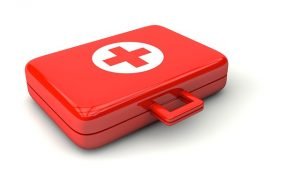Here’s what you can do if you see emergency symptoms in your animal:
 Safety first. If an animal is in pain, she may bite you. Even if she loves you dearly and is a super sweet dog or cat. Covering her head with a towel or wrapping a leash or soft cord around her mouth is helpful.
Safety first. If an animal is in pain, she may bite you. Even if she loves you dearly and is a super sweet dog or cat. Covering her head with a towel or wrapping a leash or soft cord around her mouth is helpful.- Assess her visually. Is she breathing, is there bleeding, is she moving?
- Carefully examine. Gently feel for swellings, pain on moving joints, gum color and capillary refill time (which is explained below).
- If time allows, a complete TPR (temperature, pulse and respiration) is useful to help the assessment.
Rush right to ER if:
There is any major trauma such as being hit by a car or falling from a height. Bring her for professional evaluation even if she seems OK after these injuries.
Do not wait if you see:
- Abdominal bloating, multiple episodes in an hour of retching or vomiting.
- Continued or large amounts of bright red bleeding.
- Inability to urinate in any animal but especially male cats.
- Collapse, difficulty breathing or blue tongue or gums.
Call and email your veterinarian if there is time.
- If you go to the ER or your local conventional veterinarian and they determine that the problem is life-threatening, you should just let the emergency vet and critical care specialist start any indicated life-saving treatment (including hospitalization, IV fluids, testing, further supportive medications, etc.).
- If the veterinarian says that your pet’s problem is not life-threatening, now’s a great time to breathe and reassess. Take a moment to think before you act. Does the ER or referral hospital vet now want to pursue further diagnostic testing to reach a diagnosis? If so, and if cost is not a concern, or if you have a pet insurance policy, then now might indeed be a great time to do these tests.
However, if you don’t have pet insurance or are watching your budget, ask the ER vet if there is a problem with having your regular doctor do the work up tomorrow (or after the weekend). The same tests may cost a lot less when run by your regular vet.
If you do have pet insurance, the expense of the ER tests should be partially (up to 80-90%) covered. This is another big benefit of working with a quality insurance company like Nationwide (VPI), Embrace or Pet Plan.
Even if you go ahead with the tests, ask what they may show and whether the results would change the treatment approach?
- Avoid non-essential drugs prescribed by the ER veterinarian. For example, if your pup suffers a trauma and is prescribed anti-biotics and anti-inflammatories “just in case”. Many drugs decrease the energy needed to heal.
- Dose Arnica in water (use the highest potency you have) as soon possible after trauma. Add 1 large or 1-3 smaller pellets into one cup of water and give 1 tsp. You can then easily succuss and redose whenever you would have otherwise have given pain medications like Rimadyl or Tramadol.
If the Arnica improves the B.E.A.M. symptoms (Behavior, Energy, Appetite or Mood) but then they worsen, this is the time to redose. Restlessness, panting, isolating (important BEAM symptoms) and overt pain symptoms like lifting up a leg when walking, licking the injured area, are also indications to repeat the Arnica.
If symptoms persist after three doses of the Arnica, it is the incorrect remedy, so do not repeat.
- Hands on healing (massage, T-Touch, etc.), Reiki and flower essences like Rescue Remedy can help in the face of any emergency. Research has shown that therapeutic touch stimulates bone formation, decreases wound healing and helps human patients with carpal tunnel syndrome.
- When you return home, BREATHE and just sit for a time with your companion. Time for a sacred paws. You can now take the time to start putting the symptoms into context. What really happened? For example, was this truly acute, or an acute flare-up of an already existing dis-ease state?
- Now is also the time to assess and address lifestyle and contributing factors. For example, a therapeutic fast is indicated if she is vomiting from overeating or getting into the garbage. Another preventive Holistic Action! in this situation is to use a latch to prevent access to garbage, the kitty box, etc.
- If continued treatment is needed, educate yourself about both the conventional and the holistic options. Find out more about our A.S.C. (Avoid, Support, Cure) method treatment approach.
- Schedule your appointment with your regular vet. Be sure that any ER notes or test results have been faxed or emailed to them. Your appointment with a trained medical professional is the perfect time to continue interpreting symptoms in context.
Remember, an emergency symptom is just another bump in the road to better health. So don’t despair.
Our faculty and community members will help support you.
Stay well.
Dr. Jeff
*Capillary refill time (CRT) is a great way to quickly evaluate for shock, heart and lung troubles. Press your finger firmly against the gums. This will blanch the pink color. When you stop pressing, the gum color should return within a second or two. If it takes much longer this is another indication to head right to the ER.
If however your animal is not acting sick and this test seems abnormal, ask your veterinarian or another educated animal guardian if you are doing it correctly.
